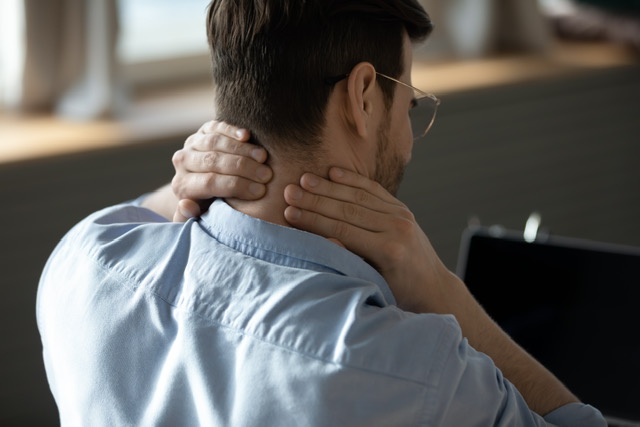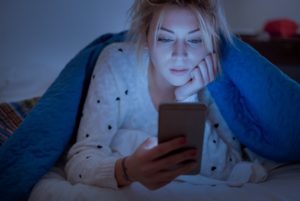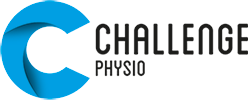
What is the biggest cause of injury?
As I’m sure you can imagine I see all sorts of ailments, injuries and traumas walking / limping into the clinic but did you know that nearly 75% of them are a direct result of the same thing?
Any ideas? Many of you may suggest gardening, football, running or another popular physical activity. I’ll give you a clue…..this ‘thing’ is often enjoyed by children as young as two and right through to pensioners!
The cause of so much pain and injury is actually a direct result of technology! That’s right, TECHNOLOGY as a whole is now the number one cause of physical and mental health issues within society.
Technology is such a huge part of our lives. It has created a new world of connectivity and socialisation meaning we can work, communicate and be ‘digitally’ active anywhere in the world, at any time. Another important factor to consider is that it has all happened in a very short space of time. Did you know:
- The first iPhone was launched in 2007;
- Apps only became available / popular in 2008;
- Social media started to take off in 2009;
- Netflix launched in the UK in 2012!
It’s crazy to think how it has significantly changed the way we live our lives in just 12 years!
So what are the main problems with technology?
Well, consider this …
A 2 year old sat watching Peppa Pig on an iPad, a teenager sat scrolling through social media on their phone, a young child sat playing games on their X-Box, an adult sat at their desk working on their laptop, a couple sat watching a Netflix series every evening … the same physical and mental issues arise from all of these examples.
Sitting – all of these situations involve sitting and often for hours on end. Sitting for long periods of time shortens many of the muscles on the front of the body, in particular, the hip flexors, the abdominals, the chest muscles (pectoralis), and the anterior shoulder muscles. This can cause muscle tension and referred pain elsewhere in the body.
Posture – Our default posture when looking at any handheld device like the phone, tablet or laptop is placing additional strain across the body creating shoulder, lower back and neck pain

Blue light – Our screens emit a Blue Light in order to achieve great clarity. The main issue of over exposure to blue light (particularly at night time) is Digital Eyestrain Syndrome This is typically defined by blurry vision, difficulty focusing, headaches, neck and back pain.
Blue light also lowers the production of melatonin (the clever hormone that helps regulate our sleep), leading to a disrupted night’s sleep. The reduction of melatonin in our system has also been strongly linked to mental health issues and depression.

Electromagnetic exposure (EM) – Mobile phones, smart TV’s, laptops and WiFi expose us to EM Fields and ultimately, EM Radiation. There is mixed research on this, however studies suggest it may be related to anxiety and behaviour disorders, hormone imbalances, increased risk of cancer, and inhibit cognitive function such as lack of attention and concentration.
Addiction – Whether it be social media, WhatsApp, gaming, e-mails, app consumption, etc, many of us are having 10 + hours of screen time each day. It’s not only our physical health that is suffering but our mental health too. Screen time addiction is scientifically proven to massively increase the risk of depression and anxiety.
Sorry to sound so doom and gloom!
There are still many positive aspects to technology use within society and its advances are impossible to ignore. We need to embrace it as it is clearly here to stay, but we really need to be mindful of the effects it is having on the human race.
As I mentioned earlier, technology has evolved far quicker than the human race and as such, research to date is only scratching the surface. The long term effects of excessive technology exposure will only become truly apparent in the years to come when we witness the impact to the younger generations!
The good news!
Please don’t despair, there are things you can do to help reduce the negative aspects of technology exposure:
Movement – Walk around whilst on the phone, get a standing desk, take regular breaks from your laptop, go for a walk / run … just DON’T STAY STILL!
Counteract the position – Some simple exercises can help you counteract the default ‘screen posture’ ultimately helping you to release, stretch and lengthen the affected muscles. Check out the ‘Posture Corrector Pack‘ for an effective and convenient solution.
Blue light reduction – Switch your phone to ‘night mode’ and try not to use your phone in the evening. There are also blue light filter apps available, along with other products such as glasses and screens for laptops which help to filter out the blue light.
Reduce exposure – Try these simple steps:
- Have the WiFi on a timer to go off at night,
- Have your phone on airplane mode when not in use,
- Don’t use your laptop on your lap,
- Don’t keep your phone in your pocket,
- Don’t charge your phone next to your bed.
There’s a great book called ‘I wish my doctor had told me this’ by Kate Chaytor-Norris. Kate covers all this and A LOT more, in a bid to help people regain homeostasis and a re-connection with themselves and the world around them. You can order a copy HERE.
Digital detox – I appreciate this is so much easier to say than do, but even if it’s a little bit each day then it’s a great start. Here are some more simple steps to success:
- Set time limits on your social media apps (and stick to them!!),
- Switch your notifications off so you’re not constantly drawn to look at the phone,
- Limit yourself to one screen when working (not your laptop, phone AND iPad!!),
- Put your phone in another room when you watch TV,
- Use an analogue alarm clock so you’re not tempted to use your phone as soon as you wake up!
This is something I think we all need to do, but also something we all struggle with, me included! But perhaps if we all make a conscious effort to take small steps now, then it might just make a huge difference to our own health and the health of others to follow!

Leave a Reply
You must be logged in to post a comment.